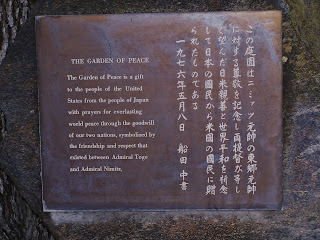

The National Museum of the Pacific War is located in the Texas Hill Country town of Fredericksburg. But not for the birthplace and boyhood home of Admiral Chester Nimitz, who led U.S. Naval Forces to victory in the Pacific during World War II, the museum’s location would seem out of place.
Today, December 7, 2009, it is exactly 68 years after that fateful day when bombs dropped on the U. S. fleet in Pearl Harbor. And, on this day, so many years after that tragic Sunday morning, former President George H.W. Bush visited Fredericksburg to reopen the George H.W. Bush Gallery at the museum, which has recently been under renovation. Bush, as a young naval aviator, flew combat missions in the Pacific during World War II, and, like my father, another young navy pilot in that theatre, flew Grumman Avenger torpedo bombers.
The museum and its grounds are divided up into different areas, with artifacts, photographs, and information detailing the Pacific Theatre of World War II. In addition to the military-oriented exhibits depicting the various stages of the war, the museum also has an outdoor plaza called the “Plaza of Presidents.” This impressive plaza has extensive information on each U.S. President who served during World War II.
Adjoining the plaza, is another area called the Memorial Courtyard, which contains a touching display of memorial wall plaques and paver bricks. These plaques and bricks are sponsored by family members, friends, and various organizations who wish to permanently recognize the specific contributions of veterans, ships, and military units.
The Japanese Garden of Peace, the most unusual part of the museum, is, arguably, one of the most important. Nimitz greatly respected Japanese Admiral, Togo Heihachiro. This Japanese Admiral, who had defeated a Russian fleet during the Russo-Japanese War, died in 1934, and his funeral was attended by the admiring Nimitz. Years later, long after World War II, Nimitz would donate money to help restore Togo’s flagship, Mikasa. This was the battleship on which Togo rose to greatness during the Russo-Japanese War, and which, at the time Nimitz pitched in to help, was in dire need of repair.
In 1976, Japan, in an honor to Admiral Nimitz and his admiration of Admiral Togo, reconstructed a Japanese garden, and a reproduction of Admiral Togo’s study, on the grounds of the museum in Fredericksburg. Amid the museum’s historical and important displays of war in the Pacific, this is a place of peace and quiet meditation.
After surviving the horrors of war, working to secure a peaceful world is one thing I’m quite sure that President George H.W. Bush, my father, Captain Kenneth Glass, USNR (Ret), and all living veterans of World War II, would agree is key to our future. Please remember them on this day, as well as the deceased veterans of that war, who sacrificed so much to secure our freedoms in the dark days following December 7, 1941, the “date which will live in infamy.”
Today, December 7, 2009, it is exactly 68 years after that fateful day when bombs dropped on the U. S. fleet in Pearl Harbor. And, on this day, so many years after that tragic Sunday morning, former President George H.W. Bush visited Fredericksburg to reopen the George H.W. Bush Gallery at the museum, which has recently been under renovation. Bush, as a young naval aviator, flew combat missions in the Pacific during World War II, and, like my father, another young navy pilot in that theatre, flew Grumman Avenger torpedo bombers.
The museum and its grounds are divided up into different areas, with artifacts, photographs, and information detailing the Pacific Theatre of World War II. In addition to the military-oriented exhibits depicting the various stages of the war, the museum also has an outdoor plaza called the “Plaza of Presidents.” This impressive plaza has extensive information on each U.S. President who served during World War II.
Adjoining the plaza, is another area called the Memorial Courtyard, which contains a touching display of memorial wall plaques and paver bricks. These plaques and bricks are sponsored by family members, friends, and various organizations who wish to permanently recognize the specific contributions of veterans, ships, and military units.
The Japanese Garden of Peace, the most unusual part of the museum, is, arguably, one of the most important. Nimitz greatly respected Japanese Admiral, Togo Heihachiro. This Japanese Admiral, who had defeated a Russian fleet during the Russo-Japanese War, died in 1934, and his funeral was attended by the admiring Nimitz. Years later, long after World War II, Nimitz would donate money to help restore Togo’s flagship, Mikasa. This was the battleship on which Togo rose to greatness during the Russo-Japanese War, and which, at the time Nimitz pitched in to help, was in dire need of repair.
In 1976, Japan, in an honor to Admiral Nimitz and his admiration of Admiral Togo, reconstructed a Japanese garden, and a reproduction of Admiral Togo’s study, on the grounds of the museum in Fredericksburg. Amid the museum’s historical and important displays of war in the Pacific, this is a place of peace and quiet meditation.
After surviving the horrors of war, working to secure a peaceful world is one thing I’m quite sure that President George H.W. Bush, my father, Captain Kenneth Glass, USNR (Ret), and all living veterans of World War II, would agree is key to our future. Please remember them on this day, as well as the deceased veterans of that war, who sacrificed so much to secure our freedoms in the dark days following December 7, 1941, the “date which will live in infamy.”
No comments:
Post a Comment